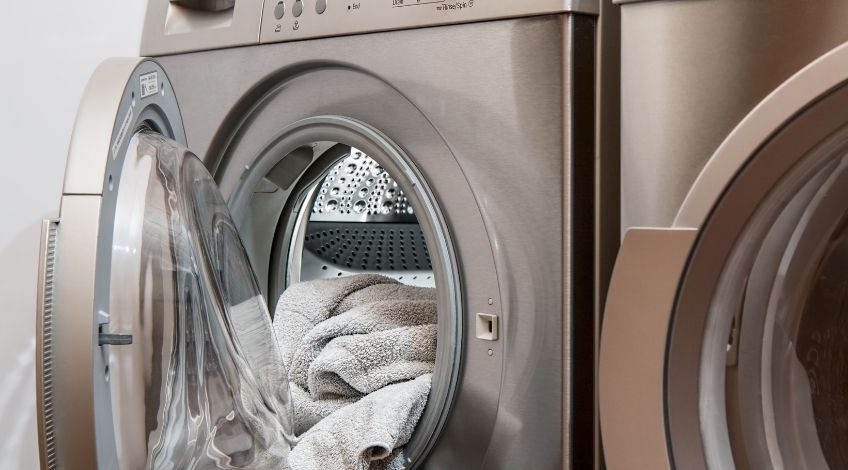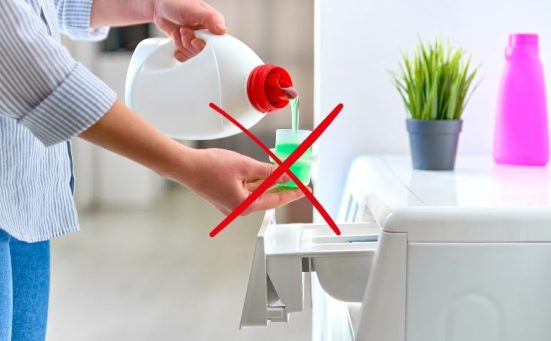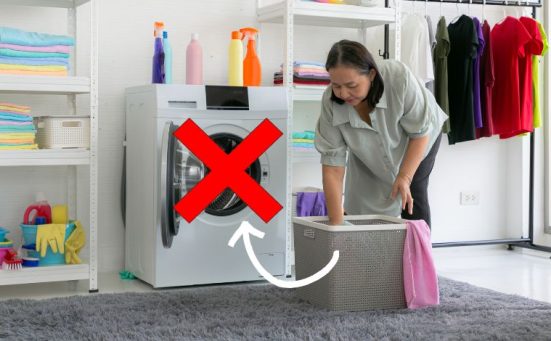
Washing Machine Not Draining? (this might be why it’s not emptying)
It can be very annoying if your washing machine has finished its cycle but is still full of water. Not only do you have a load of wet washing that you’re somehow going to have to get dry. You are also thinking about the hassle and expense of replacing your washing machine. In this article, we’ll give you expert advice on how to fix it yourself.
These are the first steps to try before calling an engineer or replacing the washing machine. If you’ve recently moved into a new property and had the machine plumbed in and it won’t drain, don’t despair there are a number of reasons for it failing. Let’s start there before examining other avenues.
Please note: unless you are a competent electrician/plumber we would advise you not to start delving into the workings of your washing machine. Accidents due to electric shocks can be fatal and taking apart your machine could void its warranty.
The Very First Things To Check
Before you do anything invasive;
- Check that your power supply is still on
- Check the machine is plugged in and switched on
- Check that the machine’s fuse has not blown
- Check that the drain pipe is not kinked or twisted
Has Your Washing Machine Stopped Draining After Moving To A New Home?
There are a number of reasons the washing machine won’t drain after having it fitted in a new house.
- The Machine connects To A U-Bend Under The Sink
If the house was empty when you moved in, it’s possible that the plumbing under the sink was “made safe” this means the plastic connecting pipe that you place the washing machine drainage hose into has been blocked to avoid any leakage. If this is the case just unscrew the connector and check for a blanking piece at either end of the pipe. In some cases a blanking piece needs removing and in other cases it’s the tapered end of the connector that needs to be cut off. - An existing obstruction has become dislodged in transit and blocked the drainage Pump
It is possible that something was left in the washing machine drum and when the machine was moved, that object has become lodged somewhere inside the pump. This could be anything from a coin, bra wire, a nail or a screw has been left laying in the bottom of the drum or inside the sump hose and become dislodged during the move. To check this; firstly remove the filter and check for obstructions, if that’s not the cause, move onto the pump impeller. - An Electrical Wire Has Become Dislodged During The Move
Unless you understand electronics, this is best left to an electrical engineer. If you do decide to tackle this yourself be sure to remove the plug from the mains before you start. - Pump Failure
If it is pump failure and it’s not caused by the pump being blocked, it is probably time to replace the pump, which is best done by a professional washing machine engineer.
If An Existing Washing Machine Stops Draining
If you haven’t moved home and your existing machine suddenly develops this fault it could be one of two things;
- The Washing Machine Is Full Of Water When The Cycle Is Finished
- Some Water Is Left In The Washing Machine When The Cycle Is Finished
The first thing you need to determine is whether the drain pump is working or not.
- If The Pump Is Running
If the pump’s running but not draining out the water, it could be a blockage somewhere in the system. It could also be a blockage in the drainage run, check under the sink and remove the connecting spigot and check for blockages and then check into the U-bend for blockages as well. The chances are if you find a blockage under the sink, once it’s removed the machine will drain freely again. Even a small piece of lint/cloth/detergent gunge is enough to prevent water flow. - If The Pump Isn’t Running
If the pump’s not running, the fault could be with the pump, like something blocking the pump or an electrical fault. Check that the impeller is turning freely and not jammed. It might be possible to hear a gentle humming sound when the machine is on but the pump doesn’t work-If this is the case, the pump is trying to work, ie, there is electrical power reaching the pump but it’s not working. This shows that the pump is working and is likely to be jammed.
When checking the pump it’s important to remember that some machines shut the pump off automatically when there’s no water inside the machine. So check if your machine will still allow the pump to work with no water before checking if the pump is working or not.
Is The Pump Filter Blocked?
To check the pump filter, firstly cover the floor with towels after draining as much water as possible from the machine. The filters on washing machines are usually easy to remove, (follow your instruction booklet for details) most twist and then lift out. Once out inspect the filter, if it has a substantial amount of cloth/material stuck inside this could account for the pump not working correctly. A small amount of fluff or the odd button is unlikely to cause the machine to not drain.
If You Find No Blockage
If you don’t find a blockage, it doesn’t mean there isn’t one, only that it’s in an inaccessible place. If that’s the case, it’s time to call an engineer.
Is The Pump Making A Grinding Noise?
If the pump is making a grinding noise, either continuously or every now and then, it’s probably something inside the pump being moved around by the impeller. It could be the pump has bearing failure, but 99 times out of 100 it will have some sort of obstruction, either a small coin, hair grip, hair band, bra wire, small screw/nail/pin or some other obstruction.
To check for obstruction in the pump, clear the machine of water, remove the pump filter you will then be able to see inside the pump (where the impeller is situated) and check for obstructions. It is also possible for the pump to be working and the impeller not turning in which case you’ll need a new pump and unless you are very confident it’s time to call an engineer.
How To Drain A Washing Machine

If your washing machine won’t drain the water away, and you need to drain it manually just follow these simple steps.
- Turn Off Mains Power
Remove the plug from the socket to isolate the power from the washing machine. - Cut The Water Supply
Isolate the water supply by turning the tap to the off position, if your machine uses both hot and cold supplies you will need to turn both off. These will be either red and blue pipes attached to the machine or red and blue taps attached to the pipes attached to the machine. - Remove the drain hose from the plastic pipe
This is usually attached to the wall and the drain pipe will usually just slide from this plastic pipe. - Lower the drainage pipe into a bucket
Be sure to have the bucket in place before you remove the drainage pipe from the plastic pipe. If the water doesn’t flow or trickles slowly the pipe is probably blocked. Break up the blockage using a plumber’s snake or use an unclogging solution. - Check the drainage pump filter
Place some towels on the floor to absorb any seepage, untwist the filter and remove from the machine. Inspect the filter, if it’s blocked remove blockage and replace.
Using Too Much Detergent
A common reason for water remaining in a washing machine drum after the cycle has finished, is excessive detergent usage. This is a common problem because often detergent manufacturers change their recipes of ingredients at various times. It could be you are using the same detergent you have used for many years but the amount of detergent needed has changed. Check the packaging this could be the problem.
Check The Machine’s Program
On most machines nowadays, there are a number of programs that don’t drain the machine. These include; anti-crease, night cycles and even stop water in drum.
Washing Machine Checklist
For a quick, easy way to diagnose what’s causing your washing machine to not drain the water from the drum, follow this checklist. One to nine are possible solutions, if the machine is beyond repair, go to number ten.
- Check the power supply is live
- Check the machine is plugged in and turned on
- Check the fuse has not blown in the plug
- Check the wash cycle on the machine
- Check the amount of detergent you need to use
- Check the drainage pipe is not twisted or kinked
- Check waste pipes under the sink
- Check the pump filter on the machine
- Call an engineer
- Replace washing machine
Frequently Asked Questions
The most common reason a washing machine is not draining is due to a blockage in the water pump filter. To fix it remove the filter and remove the blockage.
The usual reason for a front load washing machine to not drain and spin is a clogged drain pump.
A replacement washing machine drain pump will cost anywhere between £15 to £50 depending on make and model. Fitting will cost between £80 to £120 approximately.
If the repair will cost less than 50% of the cost of a new machine and your existing machine is relatively new, then it is definitely worth fixing your washing machine.
A common age for a washing machine is around 10 to 13 years.
Also, follow us on Pinterest ...



